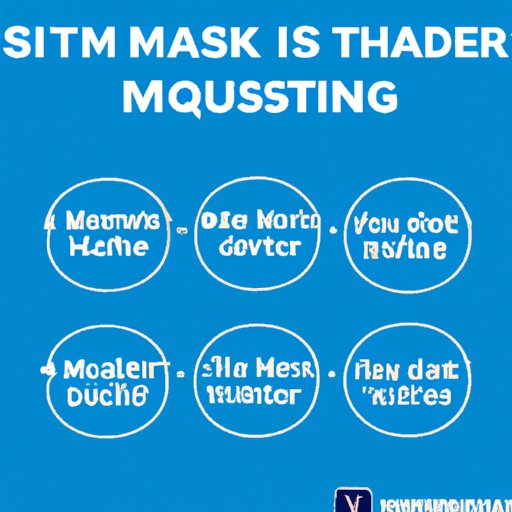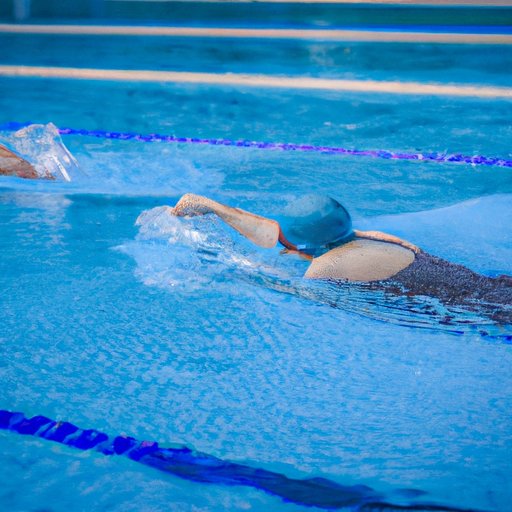Introduction
If you grew up near water, you might have started swimming at a young age. However, those who didn’t have the opportunity as kids might still feel anxious about getting in the water. If you’re one of those individuals, you’re not alone. Learning how to swim is an essential life skill, and the sooner you begin, the sooner you enjoy all the water-related activities to the fullest.
But learning how to swim is more than just jumping in a pool and kicking your feet. In this article, we’re going to provide a beginner’s guide to help you learn how to swim. You’ll learn the essential skills, the right techniques, necessary equipment, benefits, and a few advanced techniques to take your swimming to the next level.
Tips for Beginners: 7 Steps to Take Before Hitting the Water
Before you start swimming, there are some important steps you should take as a beginner to build confidence around the water, and prepare your body for the exercise.
1. Assess your health condition
Swimming is one of the best forms of exercise, but it’s still vital to ensure you’re healthy enough to start swimming. Consult with your doctor to make sure you don’t have any health conditions that might prevent you from getting in the water.
2. Gear up
Make sure you have the appropriate swimwear for the pool or open water. Swimwear should fit snugly, but not too tightly, to improve mobility and prevent water resistance. Don’t forget a pair of swim goggles to prevent irritation and for improved underwater visibility.
3. Hydrate
Swimming is an intense cardio workout and can quickly dehydrate you. Ensure you stay hydrated, especially if you’re swimming in an open water body.
4. Warm-up
Just as with any other form of exercise, you need to warm up your body before getting in the water. Warm-up exercises can include a few laps of walking or light stretching. It’s important to avoid pulling a muscle or hurting yourself while swimming.
5. Learn basic swim strokes
If you’re a beginner swimmer, it’s helpful to master the basic swim strokes first, like the breaststroke, freestyle, backstroke, and butterfly. They are the foundation of swimming techniques, and the more comfortable you are with these basic strokes, the better your chance of learning advanced techniques.
6. Take swimming lessons
If you’re new to swimming and want to reach your full potential, taking swimming lessons from an experienced instructor can help ease your mind and accelerate your learning curve. You can find swimming lessons at a local recreation center, swimming school, or gym.
7. Start in shallow water
Start swimming in shallow water that’s no deeper than waist level and gradually move to deeper water. This way, you can get comfortable before going into deeper water, which can be daunting for new swimmers.

Master the Fundamentals: 5 Essential Skills to Improve Your Swimming Technique
After getting comfortable in the water, mastering fundamental swimming skills is the next step to improving your technique. These essential skills are critical for developing your swimming ability and unlocking the benefits of swimming.
1. Breathing
Proper breathing technique is essential for swimming and should be practiced before moving on to more advanced techniques. The most common breathing technique is to take a deep breath, hold it, and then exhale while your face is submerged. As you become more comfortable, you can practice breathing on alternating strokes.
2. Body position and balance
Body position and balance are significant for speed and efficiency in swimming. In swimming, your head should be in line with your spine, and your body should be horizontal to improve your hydrodynamics in water. You can train your balance and body position through kicking drills and practicing core exercises.
3. Kicking
Proper kicking technique is essential for speed and proper body position in the water. Kicking exercises like the flutter kick and scissor kick are great for training your leg and kicking techniques. To avoid exhaustion, focus on the up and down kick with light but fast movements.
4. Arm movement and technique
Arm movements are crucial for effective swimming. Proper arm movement and technique can help you maintain speed and increase endurance. Practicing arm drills like the single-arm drill, arm circle drill, and catch-up drill can help you refine your technique and improve your arm strength.
5. Coordination
Coordination is vital for swimming as it involves coordinating your body, breathing, and movement. You can enhance your coordination by doing drills that focus on integrating your arms, legs, and breathing.
The Benefits of Swimming: How Regular Swimming Can Transform Your Health and Fitness
Many fitness experts and doctors recommend swimming as one of the best forms of exercise. Swimming benefits your muscles, lungs, heart, and overall wellness. Swim regularly to experience the following health benefits:
1. Build muscle strength and endurance
Swimming is one of the best exercises when it comes to strength-building. It works out all the muscle groups in your body to improve muscle strength and endurance.
2. Enhance cardiovascular capacity
Swimming is an effective cardiovascular exercise that can improve your heart and lung function. Swimming helps to strengthen your heart muscle for better circulation and relaxation.
3. Relaxation and stress relief
Swimming is an excellent relaxation tool and helps relieve stress. Swimming has been shown to promote relaxation and cognitive flexibility, which can account for its positive impact on stress.
4. Reduced inflammation
Swimming has been shown to decrease inflammation in the body, which has a range of positive health implications.
5. Weight loss and maintenance
Swimming is an excellent exercise for weight loss and maintenance. Swimming burns more calories than running, making it a great training option for those trying to burn more calories.
Common Mistakes to Avoid: 6 Pitfalls to Watch Out for When Learning to Swim
Learning how to swim involves mastering the right techniques, but it also involves avoiding certain pitfalls that can hinder your progress.
1. Holding your breath
In swimming, holding your breath can result in unnecessary stiffening and stress in your body, which can affect your body shape, speed, and technique.
2. Poor body and head position
When swimming, your head and body position are crucial for proper swimming technique. Improper head and body positions can lead to slowing your progress and inefficient use of your energy.
3. Over-relying on the kicking
Beginners often turn to kicking as a coping mechanism to avoid poor body position. Over-reliance on kicking can lead to fatigue and hinder your swimming progress.
4. Neglecting strength training
Though swimming is an excellent full-body workout, it is crucial to supplement your swimming with strength training to improve your overall fitness.
5. Incorrect timing of breathing
Correct timing of breathing is essential for efficient swimming. Beginners often take uncalculated breaths and find themselves out of breath before they finish the first lap.
6. Swimming without purpose
Swimming without purpose can lead to dedicated practice time without any progress. You need to have specific goals to ensure that you are practicing with intention and increasing your swimming abilities.
Swim Gear Essentials: A Beginner’s Guide to the Equipment You Need and How to Use It
To start swimming, you will need some essential gear to improve your technique and make your swimming more comfortable. The following are the essential swimming gear you will need as a beginner.
1. Swimsuit
Swimwear should be designed to fit snugly to reduce drag. Your choice of swimsuit is essential to both your comfort and your performance, so ensure you choose one that fits correctly.
2. Swim Goggles
Swim goggles block water and protect your eyes from salt, chlorine and other irritants in the water. Choose goggles that fit snugly around your eyes without feeling too tight.
3. Swim Cap
Swim caps are essential for keeping your hair dry and reducing water resistance while swimming.
4. Kickboard
Kickboards help to provide support during kick drills and can help isolate leg movements during swimming practice.
5. Swim Fins
Swim fins are worn on the feet and help to increase propulsion in the water while swimming. They also help to train your feet and leg muscles, improving your kicking technique.
Overcoming Fear: How to Overcome Your Fear of Water and Start Enjoying Swimming
Overcoming fear and anxiety around the water is critical for success in learning how to swim. Here are a few tips on how to overcome your fear:
1. Start Small and Easy
Begin with small steps, like standing in shallow water, dipping your head underwater, and gradually moving to deeper water. Patience and kindness with yourself are essential as you take each step.
2. Address Your Fears
Assess the source of your fears and address them. Assess and manage your fears and concerns from a rational point of view. You can try immersion therapy to help you face your fears and build up trust and confidence around the water.
3. Surround Yourself with Support
Have supportive friends and family around you. Learning to swim can be challenging, but when surrounded by a positive, supportive environment, it can make it a lot easier and enjoyable.
Advanced Techniques: 3 Swim Drills to Take Your Swimming to the Next Level
If you’re ready to take your swimming to the next level, the following drills can help improve your endurance and technique:
1. Pull-ups
Improve your upper body strength by using pull paddles or swimming with your fists instead of an open-hand grasp. Concentrate on pulling your arms through the water and squeezing your shoulder blades together on every stroke.
2. Turn Drills
Practice your flip turns and open turns with drills. Flip turns can be daunting for beginner swimmers, but with practice and determination, you can learn this advanced technique and improve your swimming speed.
3. Swim Pyramid
Swim pyramid can help to improve your endurance and overall swimming cardiovascular fitness. It involves swimming pyramid-shaped sets where you swim for increasing durations, then decrease back down.
Conclusion
Learning to swim takes patience, dedication, and effort. By following these tips, mastering fundamental skills, and overcoming fear, you can take your swimming to the next level and enjoy the health and fitness rewards that come with regular swimming. We hope this beginner’s guide has helped you get started on your swimming journey.
Remember, take it slow, be kind to yourself, and most important, have fun.
Now, it’s time to jump in the water and start practicing your swimming techniques. Remember, the more you practice, the better you get. Start slow, be confident, and aim to achieve each milestone as you become fitter, healthier, and a better swimmer.
